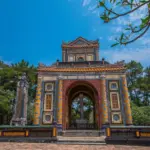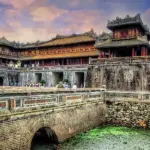Royal Citadel Hue with Ovuigo: Vietnam’s Timeless Imperial City
History and Significance of the Royal Citadel Hue
Nestled on the gentle banks of the Perfume River in Hue city, the Royal Citadel stands as Vietnam’s proud legacy of imperial strength and cultural grace. Built in 1804 under the direction of Emperor Gia Long, the Citadel was more than a stronghold—it was the cultural, spiritual, and administrative heart of the Nguyen dynasty. Spanning over 520 hectares, this massive complex, also known as the Complex of Hue Monuments, encapsulates not just buildings but the ethos of a nation.
The Citadel’s purpose was to shelter the imperial family and senior mandarins, making it the unwavering symbol of royal authority, order, and Vietnamese traditions. The design drew inspiration from Chinese geomancy, ensuring auspicious positioning relative to the mountains and winding river. The emblematic dragon, phoenix, royal seal, lotus, and imperial flag motifs are seen everywhere, laying the visual foundation of Vietnamese imperial imagery. Declared a UNESCO World Heritage Site in 1993, the Citadel’s stature on the global stage is undeniable. War, nature, and time have threatened its structures, but the story—and spirit—of the Imperial City lives on as a symbol that Vietnam’s cultural heart beats with undiminished pride.
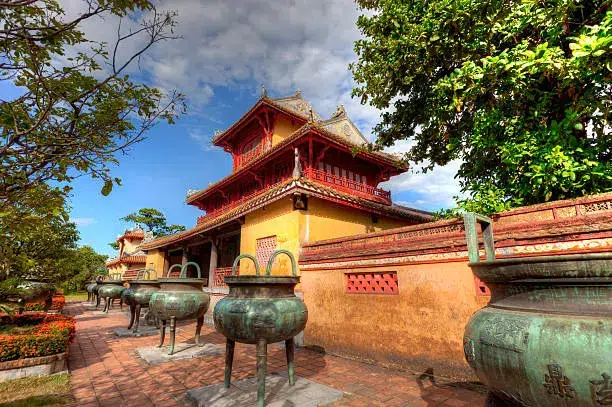
Imperial City Architecture and Design: Fortified Walls, Ngo Mon Gate, and Forbidden Purple City
The Imperial City of Hue was a feat of military strategy wrapped in royal elegance. Fortified walls, stretching 2.5 kilometers and rising up to 6.6 meters, were designed to endure sieges while conveying grandeur.
The duo of walls and moats, with moats averaging 30 meters in width, created an unassailable perimeter—hinted at by unique cannon placements and secret tunnels that still intrigue visitors today.
Enter via the Ngo Mon Gate, an iconic structure bordering on the mythic, adorned with five entrances symbolizing imperial order: the central portal was reserved for the Emperor alone. The bridge over the moat, with its lotus motifs, welcoming all those who entered to consider their steps as sacred. Passing through, visitors reach the Forbidden Purple City—the Nguyen dynasty’s own version of China’s Forbidden City, but sculpted for Vietnamese royalty. This exclusive enclave was shielded from view, emphasizing privacy, reverence, and security.
Within, the halls are marked by Mandarins Hall, dragon and phoenix carvings, and imperial decree rooms—a showcase of Vietnamese imperial style blending Confucian philosophy and local artistry.
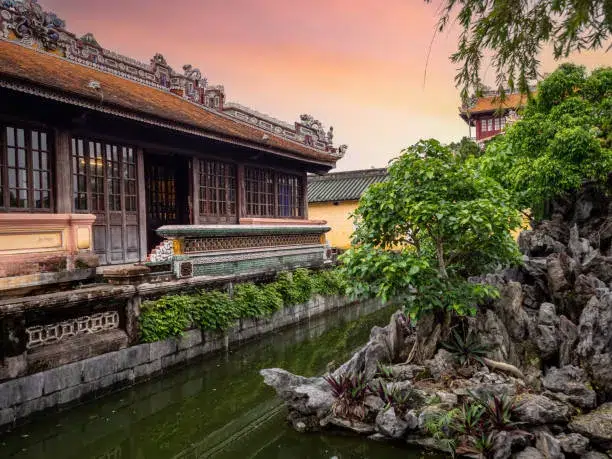
Highlights of the Hue Citadel with Ovuigo: Thai Hoa Palace, Flag Tower, and Nine Sacred Cannons
Several treasures lie inside the fortified heart of the citadel. The Thai Hoa Palace commands the most gravitas: it was the ceremonial heart, hosting coronations and state rituals. Its grand wooden structure glows with lacquered red and gold, while the throne sits beneath embroidered dragons—a classic emblem of Nguyen emperors. The Hall is a masterpiece of royal architecture and history.
The towering Flag Tower is another iconic symbol—it dominates the skyline and once bore the imperial flag, fluttering as a hopeful signal to courtiers and the city. Close by, the Nine Sacred Cannons—cast in 1803, and each representing the elements and the power of the dynasty—guard the Citadel’s main gates. Their scale and placement are not merely defensive but ceremonial, reflecting the unity and longevity of Nguyen rule.
Wander among these structures, and each tells a fragment of the broader saga: of power, artistry, and the ambition of an ancient capital forever remembered.
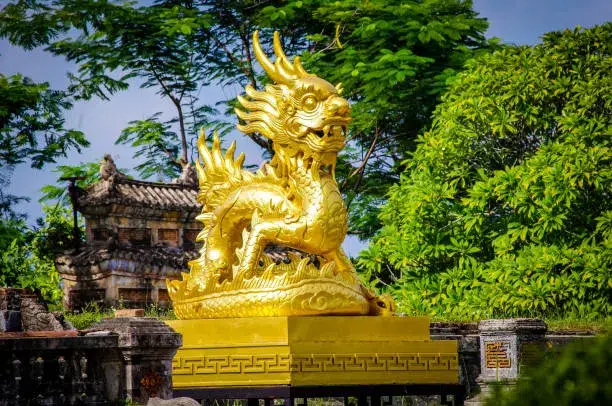
Cultural Heritage: Court Rituals, Nhã nhạc Music, and the Role of the Perfume River
Culture is the soul of the Citadel. Traditional court rituals—today reconstructed for visitors—offer glimpses of the world where the Nguyen emperors once presided. Costumed reenactments, drawn from detailed chronicles, let guests step back into a time of imperial processions, royal decrees, and civil ceremonies.
Nhã nhạc, the elegant court music of Hue, carries a haunting serenity that once filled the Imperial City’s courtyards. Recognized by UNESCO as an Intangible Cultural Heritage, Nhã nhạc is still performed here by skilled musicians using gongs, zithers, and bamboo flutes. The music, with its slow rhythms and quiet grandeur, is a pillar of Vietnam’s royal legacy.
The Perfume River courses through it all—hosting festivals and playing a vital role in imperial religious life. The river’s banks saw dragon boats, ritual offerings, and the dawn-to-dusk rhythms defining Hue’s unique court culture. Each year, the Hue Festival brings this blend of music, rituals, and water processions back to life.
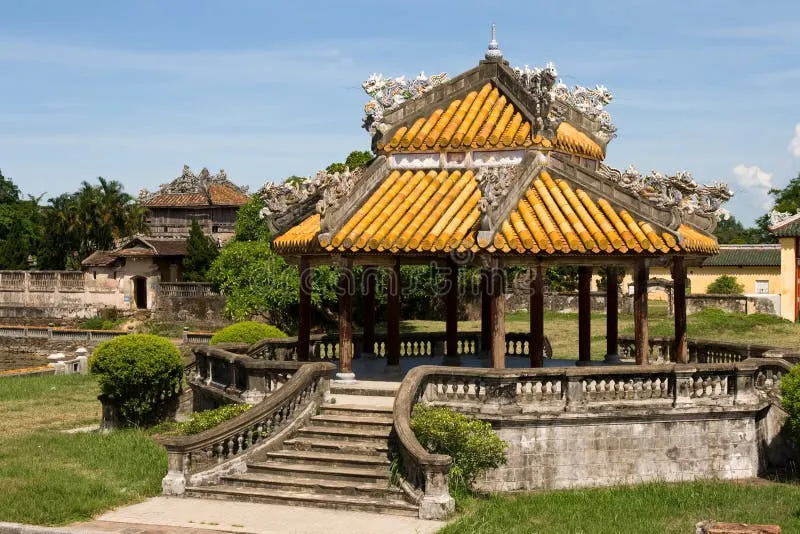
Visiting the Royal Citadel Hue: Guided Tours, Opening Hours, and Best Time to Visit
Visiting the Hue Historic Citadel is an experience no traveler should miss. The main entrance is through the Ngo Mon Gate. Standard visiting hours run from 7:30 AM to 5 PM daily. Adult tickets for foreigners are 200,000 VND; for children, 40,000 VND. Tourists should refer to the official Hue World Heritage website for event updates and price changes.
For an immersive experience, consider a guided tour; knowledgeable guides reveal hidden stories and take you beyond what guidebooks offer. Guided tours can be booked through local providers like Ovuigo.
The best months for visiting are between February and April or September and November. These periods offer cool weather and lower rainfall—ideal for walking the palace gardens and admiring ancient architecture. Schedule your trip to coincide with the biennial Hue Festival for a vibrant cultural showcase.
See the location on Google Maps: Royal Citadel Hue
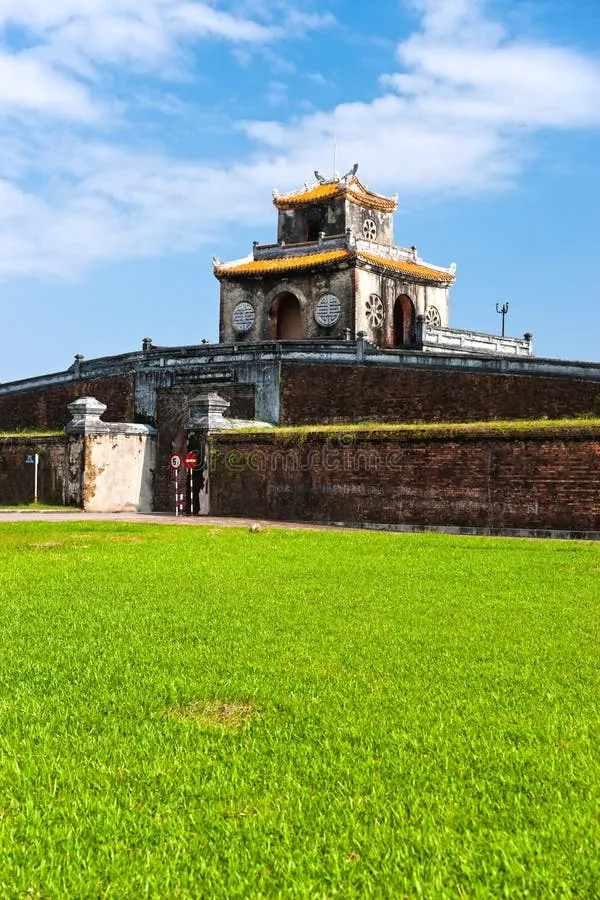
Preservation, Restoration Efforts, and War Damages of the Imperial City
The Imperial City’s tumultuous history is also a story of resilience. The Vietnam War, along with earlier conflicts and floods, left substantial scars. Many structures—like the Forbidden Purple City—were heavily damaged or lost. In recent decades, concerted restoration efforts have taken place with support from the Vietnamese government, UNESCO, and international partners.
Restoration teams painstakingly research ancient construction techniques, using archival documents, historic photographs, and surviving artifacts. The focus isn’t just on buildings: decorations, gates, ancient inscriptions, and unique cannon placements are all targets of preservation. Education and awareness campaigns encourage locals and tourists alike to respect and support conservation.
Preservation is continuous and adaptive, reflecting Vietnam’s commitment to honoring its past and inspiring pride in new generations. The goal is not simply to create a static museum, but to keep the Imperial City as a living, breathing part of Hue’s fabric.
We don’t run tours — we craft experiences. Each journey is a story written just for you, designed for those who wish to explore Vietnam slowly, deeply, and meaningfully. No fixed itineraries. No crowds. Just you — and the moments that truly matter. For bespoke Hue adventures, connect with us via WhatsApp: +84868319161.
For memorable stays during your Vietnam journey, discover The Manor Hoi An at The Manor Hoi An, Hola 1 at Hola 1, and Hola 2 at Hola 2.

